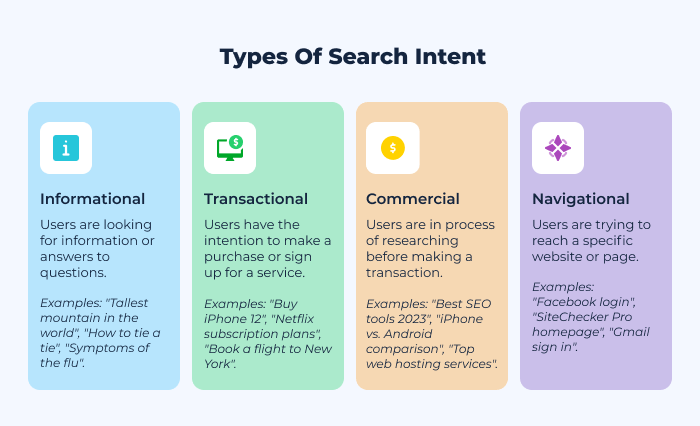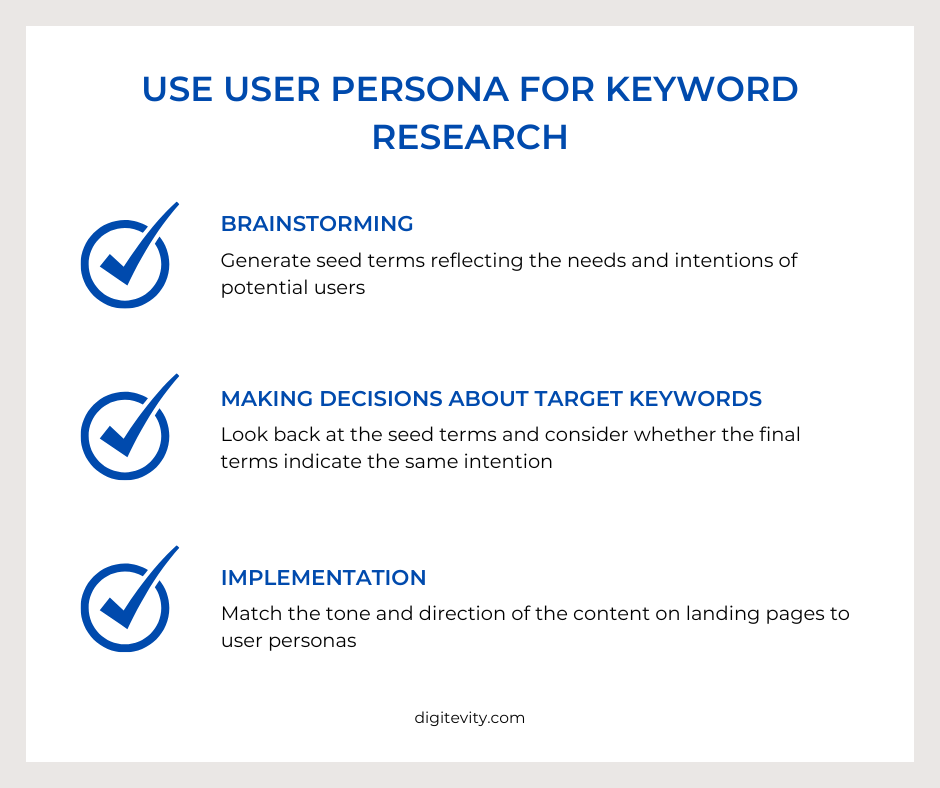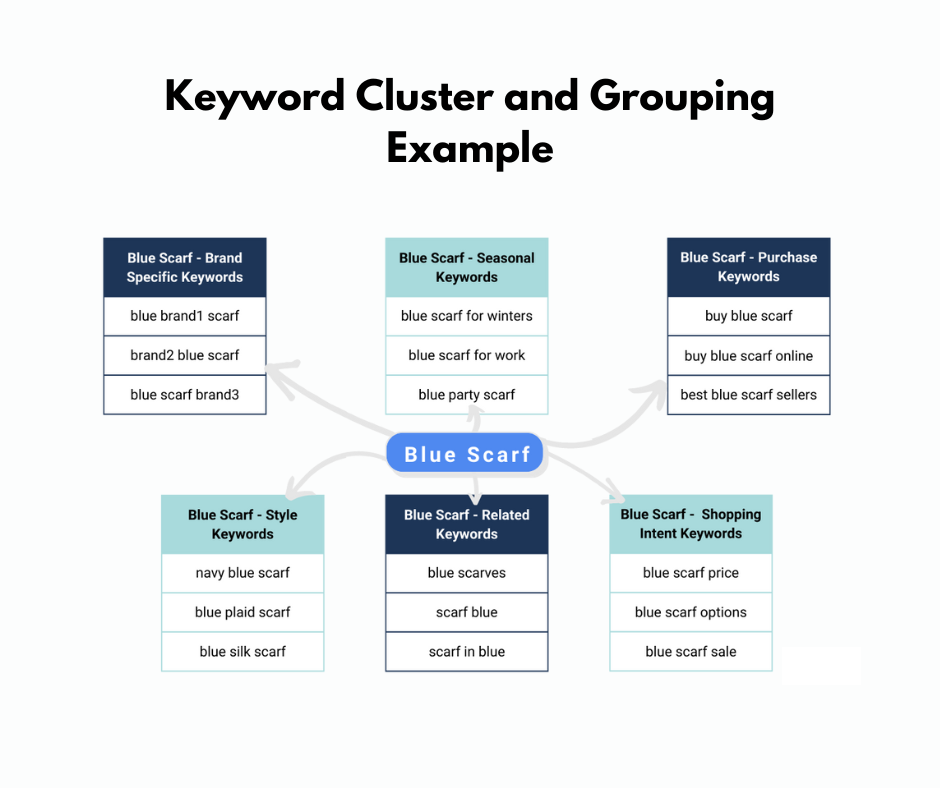Revenue Driven for Our Clients
2,120,240,443

Ecommerce keyword research is a foundational strategy for driving high-quality, revenue-generating traffic to your online store. But to truly gain an edge, it’s essential to go beyond surface-level keywords.
This guide will break down the nuances of keyword research tailored for ecommerce, focusing on understanding buyer intent, exploring untapped keyword sources, and implementing data-driven tactics to maximize traffic and conversions.
Let’s dive right in!
An in-depth understanding of buyer and search intent drives e-commerce conversions and revenue. Search intent in e-commerce ranges from top-of-funnel awareness to bottom-of-funnel purchase intent:

Including visuals like a funnel graphic can show how these intents move users closer to purchase, highlighting the value of intent-based targeting.
Data shows that transactional keywords tend to convert best, with informational terms driving significant top-of-funnel traffic that nurtures leads.
HubSpot found that businesses that blog get 55% more traffic, meaning informational content can be a valuable lead-generation asset when paired with engaging content or remarketing strategies.
Practical Tip: Use specific modifiers—like “buy,” “best price,” and “discount”—to capture high-intent searches. Location-based keywords like “near me” or “city names” also increase relevance for local search results, particularly for ecommerce businesses with physical locations.
In ecommerce SEO, targeting both core keywords and long-tail keywords forms the foundation for robust, well-rounded keyword strategy:
Tailor keywords to reflect buyer personas. Eco-conscious shoppers might search for phrases like “eco-friendly skincare for sensitive skin.” This approach of mapping keywords is to identify the user, and problem-solving motivations, and create a more personalized user journey.

Tool Recommendations: Ahrefs and Semrush excel at distinguishing core and long-tail keywords.
Additionally, tools like People Also Ask (PAA) Extractor or AnswerThePublic reveal specific questions users ask, providing keyword opportunities that go beyond general search tools.
Identifying competitors’ high-value keywords can disclose opportunities and fine-tune your targeting. Start by examining keyword performance on high-ranking ecommerce pages of competitors.
Use Semrush’s Organic Research Tool or Ahrefs’ Site Explorer to study top-ranking keywords on competitor product pages.
Analyze keywords based on traffic and conversion potential. Including charts or screenshots from these tools could illustrate insights.

Fill keyword gaps by looking beyond high-volume terms. By performing gap analysis, you can identify long-tail and lower-competition keywords competitors are underutilizing, like niche product variations or blog topics related to purchase decisions.
Unique Tactic: Check FAQ or blog sections on competitor websites for keywords related to top-of-funnel queries.
For example, competitor FAQs can inspire keywords like “how to use retinol in winter,” which can support category pages for skincare products.
Explore non-traditional keyword sources for a competitive advantage. These user-generated platforms provide insights into how potential customers describe and search for products:
Monitor Reddit, Quora, and Facebook Groups for questions or phrases users naturally use. For instance, searching “best skincare routine Reddit” can uncover conversational keywords not often found in traditional keyword tools.
Amazon, eBay, and Walmart are goldmines for ecommerce keyword insights. Product search suggestions and category keywords can reveal high-interest terms, especially for newer or trending products.
Analyze keywords from user reviews, which often reveal detailed, product-specific phrases that resonate with real users. For instance, “long-lasting moisturizer” or “no harsh chemicals” could be keywords derived from common review themes in skincare.
To maximize conversions, prioritize keywords by their revenue-driving potential and assign them strategically across your site’s structure:
High-ROI keywords align with focus on intent and product relevance. Prioritize high-volume and high-converting keywords, especially for high-margin products.
Assign high-traffic keywords to category pages (e.g., “organic skincare”), while long-tail keywords work best on product-specific pages (e.g., “organic skincare moisturizer for acne-prone skin”).
Use CPC data as a quick indicator of a keyword’s commercial value. High CPC keywords reflect competitive markets with high buyer intent. Consider adding a visual comparing CPC data for various keywords to show their revenue potential.
An advanced keyword clustering strategy not only enhances content but also improves your ecommerce site’s link structure:
Group related keywords to cover broader topics within your category pages, blog posts, and product descriptions. For instance, clustering keywords like “organic skincare benefits,” “how to choose organic skincare,” and “best organic ingredients” help target a wider audience and satisfy different intents.

Strategically link cluster pages to improve site architecture and distribute link equity. For instance, link blog posts about “how to use retinol” to a category page about skincare products with retinol. This approach is to create keyword-driven site structures that guide users through a well-organized buying journey.
Effective keyword tracking lets you continuously optimize and stay competitive:
Monitor KPIs like organic traffic, bounce rates, and conversion rates. This emphasizes data-based refinement, so track metrics like average order value and return on ad spend (ROAS) for ecommerce-specific insights.
Regularly reassess keyword performance, focusing on trends in rankings, conversions, and engagement. Adjust your strategy to stay aligned with search engine updates and user behavior shifts.
Visuals that show keyword ranking changes over time or comparison charts of traffic metrics can help convey these optimization steps.
Effective keyword research for ecommerce isn’t a one-time task—it’s an evolving strategy that requires consistent analysis and adaptation. By focusing on intent-based keywords and unique keyword sources, you’ll build a more resilient SEO strategy that drives sustainable growth.
Keep refining your keywords based on performance data, and align your content to meet the needs of different customer segments. With these methods, your ecommerce site can outperform competitors and secure a prominent place in search results, ultimately attracting and converting more customers.